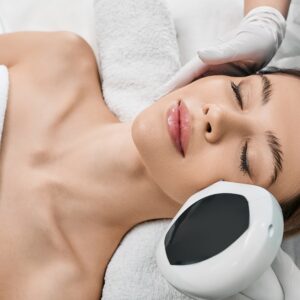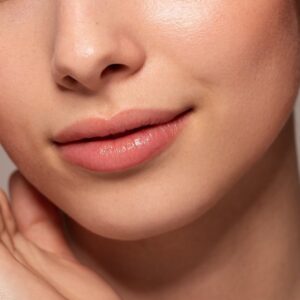1. Which laser treatment is the best for skin tightening and facial rejuvenation?
Depending on your desired results for facial rejuvenation, there are different laser procedures that may be appropriate. For skin tightening and firming, we recommend laser skin resurfacing.* At our office we preform fractional non-ablative laser resurfacing. Traditionally, two kinds of laser treatment have been available for cosmetic skin treatment: ablative and non-ablative. Typical ablative treatments, which use a high temperature to vaporize unwanted tissue, can be effective—but with significant side effects and several weeks of recovery time.* Non-ablative treatments, meanwhile, have very few side effects and low downtime, but they may require more treatment sessions. We see excellent outcomes with fractional non-ablative skin resurfacing.*
For patients looking to treat the visible signs of photo damage such as irregular pigmentation and redness, we recommend Intense Pulsed Light treatments, also referred to as IPL. IPL is used to treat brown spots and redness on the face, neck and chest.*
2. Do laser treatments stimulate collagen production?
Certain laser procedures, such as laser skin resurfacing do stimulate collagen production.* With the fractional non-ablative procedure we offer at The Center for Dermatology and Laser Surgery the treatment creates heated columns in the skin that stimulate collagen to be produced around the heated columns.* The collagen helps to plump up the dermis and soften the lows and highs of the skin. This softens facial lines and also tightens the skin.*
3. What is the best time of the year for laser skin resurfacing?
With fractional non-ablative skin resurfacing, avoiding the sun is not as critical as with other laser procedures, such as IPL, due to the nature of the treatment. Patients can elect to have this treatment at any time of the year. The sun however does cause damage to the skin and we recommend that you are wearing SPF 30 or greater daily and doing your best to protect your skin from sun exposure.
4. What is the best laser treatment for scars and large pores?
Acne scars can appear as depressed or uneven areas of the face, small holes in the skin called “ice pick” scars, or raised red or pink scars. Previously, acne scar treatment was traditionally treated with Erbium and Carbon Dioxide laser resurfacing. While these procedures can yield excellent outcomes, they do require post-care and several days of post procedure downtime.* We now have a wide range of non-ablative lasers to treat these types of scars including the Pulsed Dye Laser (PDL) the Affirm Multiplex and the ICON 1540 fractional laser. These types of devices gradually resurface scars requiring short down time periods.*
Large pores can also be improved with this type of laser skin resurfacing. With the increase in collagen production, the appearance of pores can be decreased. This outcome may be subtle, so patients should discuss their goals with their provider to determine whether this treatment may provide the desired level of improvement.*
5. Which treatment is better for chin and upper lip lines Fractional Laser or Fillers?
Depending on each individual patients needs and goals, either Fractional Laser, Fillers, or both treatments may be appropriate. Fractional Laser treatment will soften fine lip and chin lines, but if there is significant volume loss fillers may be required to achieve the desired outcome.*
6. Which laser is best for neck tightening with minimal downtime?
For neck tightening, we generally utilize the Affirm Multiplex laser.* This treatment would fall under the category of fractional non-ablative skin resurfacing. We have seen excellent results, with minimal downtime, with this laser. When considering laser skin resurfacing for neck tightening, it is important to evaluate your goals with your provider. While the results we see with fractional laser treatment are impressive, it is important to note that the results are not comparable to a neck lift.* As such, discussing your end goals with your provider is prudent to determine if you will be satisfied with the end result.
7. What are the potential side effects of Non-Ablative laser skin resurfacing?
Potential side effects post laser skin resurfacing can include the following: infection, mild swelling and redness, or blistering. Infection can occur from a flare of the herpes virus. Blistering is also a rare side effect. It is important to discuss your medical history with the provider to ensure a safe and effective treatment. Also, it is important to choose your laser practitioner with care. We certainly would recommend researching your provider to determine if they are well trained and experienced in utilizing these devices.
8. How long should I wait between laser treatments?
For laser treatments such as fractional resurfacing, we generally advise waiting a month in between treatments. For every different laser procedure, there are different recommended times between treatment. Ultimately, this will be determined in consultation with your provider.
9. What is the best skin aftercare following Non-Ablative laser resurfacing?
After the procedure, you will be red and swollen and your skin will feel tight. You will be asked to ice the area treated for 30 minutes immediately post treatment. You will need to avoid glycolic, salicylic acid, and topical vitamin A derivative creams for 2-3 days. You will probably want to avoid warm water on the area treated for 2-3 days and wash only with cold water. About 3 days after treatment you may feel very dry and a well hydrating moisturizer that is non-irritating should be used on the skin. You also want to be sure to protect your skin with sunscreen post treatment.





